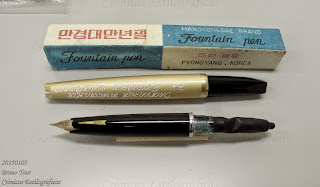By the 1960s, Japanese companies had long started to design and produce their own original models after the hard post-war years. One of those was the pocket pen. Sailor put that concept to work in 1963 and most Japanese companies soon followed the trend, Platinum among them as early as in 1964. And not only Japanese companies paid attention. Now we know that North Korean pen brand Mangyongdae, from Pyongyang, was also interested in the Japanese developments.
The Korean version –this Mangyongdae, 만경대— follows closely the style of the Platinum pocket pen of the time, mid 1960s. It shows a long, quasi triangular damascene decoration, and a nib geometry very close to those of the Platinum. The filling system, however, is different—a self-filling integrated sac does the job instead of the usual cartridge of the Japanese original. The nib is made of 12 K gold, and carries the name of the brand written in Chosongul characters.

The Mangyongdae's nib is engraved with the gold purity, 12 K, and the brand name in Korean: 만경대. The cap carries an inscription in Cyrillic characters--an aftermarket addition.
Incidentally, this pen is engraved with some inscription in Cyrillic characters. The pen was bought in Bulgaria, and that inscription only shows the economic connections among the countries in the area of influence of the Soviet Union.
That is not the only North Korean pen copying a Platinum pen. The following example clearly shows its Japanese influence—again, a damascene inlaid (zogan in Japanese) following the pattern of some Platinum from the 1960s. And, as in the previous case, a Platinum-type nib made of 12 K gold, engraved with the brand name, Chullima (천리마, also read as Chollima), as was the case of the copies of the Parker 51 made in North Korea.

The Platinum original. Note the nib geometry and the size and shape of the inlaid decoration, laid in reverse. More pictures of this Platinum pen can be seen on the Chronicle Sixties Music.
Its filling system departs from the Platinum original cartridge—it is a self-filling bulb filler.
Every industrial revolution, save the English original, is started by copying. North Korea was no exception, but the industrial power that this country was after the Second World War and during the Korean War (1950-1953) failed as soon as the Soviet Union collapsed. Fountain pens are not of any industrial value nowadays, of course, but they were so in the 1950s and even 1960s, and the fact that there existed a production of these consumer goods in North Korea is an obvious sign of its lost industrial capability.
My thanks to Mr. Sunami.
NOTE (Nov 10, 2020): Fellow blogger Tefolium made an excellent research on the origin of a number of fountain pen operations in countries with strong ties with the People's Republic of China. Among them, those in North Korea. You can read it here: https://tefolium.blogspot.com/2020/11/20201106-updated-socialist-countries.html?m=1
Montblanc 3-42G – Pilot Blue
Bruno Taut
Nakano, January 30th, 2015
etiquetas: Corea del Norte, Platinum, Chullima, Mangyongdae
Bruno Taut
Nakano, January 30th, 2015
etiquetas: Corea del Norte, Platinum, Chullima, Mangyongdae










































